Valoration of the Synthetic Antioxidant Tris-(Diterbutyl-Phenol)-Phosphite (Irgafos P-168) from Industrial Wastewater and Application in Polypropylene Matrices to Minimize Its Thermal Degradation
Abstract
:1. Introduction
2. Materials and Methods
2.1. Recovery of the Additive
2.1.1. Samples Collection
2.1.2. Extraction System for Sample and Standard
2.1.3. Separation, Identification, and Characterization System by HPLC/DAD/MS/MS/MS
2.2. Reincorporation of Wastewater Additive in the PP Production Process
2.3. Sample Evaluation
2.3.1. Heat Flux Characterization System (DSC)
2.3.2. Spectrometric Characterization System
2.3.3. Thermogravimetric Characterization System
2.3.4. Melt Flow Index (MFI)
3. Analysis and Discussion
3.1. Standards Calibration Curve for Irgafos P-168
3.2. SPE of Standards with Acetonitrile
3.3. Linearity Analysis for the Calibration Curve and SPE of Standards
3.4. Analysis of Concentration and Recovery of Irgafos 168 in Samples
3.5. FTIR Analysis of the Recovered Irgafos
3.6. TGA Analysis of the Recovered Irgafos
3.7. DSC Analysis of the Recovered Irgafos
3.8. FTIR Analysis of PP Plus Pure Irgafos P-168 and PP Plus Recovered Irgafos P-168
3.9. Melt Flow Index (MFI) and Molecular Weight Distribution
3.10. OIT
4. Conclusions
Author Contributions
Funding
Institutional Review Board Statement
Informed Consent Statement
Data Availability Statement
Conflicts of Interest
References
- Hazarika, M.; Dixit, U.S.; Davim, J.P. History of Production and Industrial Engineering through Contributions of Stalwarts. Manuf. Eng. Educ. 2019, 1–29. [Google Scholar] [CrossRef]
- Cao, L.; Lin, C.; Gao, Y.; Sun, C.; Xu, L.; Zheng, L.; Zhang, Z. Health risk assessment of trace elements exposure through the soil-plant (maize)-human contamination pathway near a petrochemical industry complex, Northeast China. Environ. Pollut. 2020, 263, 114414. [Google Scholar] [CrossRef] [PubMed]
- Gebbink, W.A.; van Leeuwen, S.P. Environmental contamination and human exposure to PFASs near a fluorochemical production plant: Review of historic and current PFOA and GenX contamination in the Netherlands. Environ. Int. 2020, 137, 105583. [Google Scholar] [CrossRef] [PubMed]
- Nie, M.; Nie, H.; He, M.; Lin, Y.; Wang, L.; Jin, P.; Zhang, S. Immobilization of biofilms of Pseudomonas aeruginosa NY3 and their application in the removal of hydrocarbons from highly concentrated oil-containing wastewater on the laboratory scale. J. Environ. Manag. 2016, 173, 34–40. [Google Scholar] [CrossRef]
- Kumar, L.; Chugh, M.; Kumar, S.; Kumar, K.; Sharma, J.; Bharadvaja, N. Remediation of petrorefinery wastewater contaminants: A review on physicochemical and bioremediation strategies. Process Saf. Environ. Prot. 2022, 159, 362–375. [Google Scholar] [CrossRef]
- van Oosterhout, L.; Dijkstra, H.; Borst, D.; Duijndam, S.; Rehdanz, K.; van Beukering, P. Triggering sustainable plastics consumption behavior: Identifying consumer profiles across Europe and designing strategies to engage them. Sustain. Prod. Consum. 2023, 36, 148–160. [Google Scholar] [CrossRef]
- Pivato, A.F.; Miranda, G.M.; Prichula, J.; Lima, J.E.; Ligabue, R.A.; Seixas, A.; Trentin, D.S. Hydrocarbon-based plastics: Progress and perspectives on consumption and biodegradation by insect larvae. Chemosphere 2022, 293, 133600. [Google Scholar] [CrossRef]
- Sridharan, S.; Kumar, M.; Saha, M.; Kirkham, M.; Singh, L.; Bolan, N.S. The polymers and their additives in particulate plastics: What makes them hazardous to the fauna? Sci. Total Environ. 2022, 824, 153828. [Google Scholar] [CrossRef]
- Marcato, B.; Guerra, S.; Vianello, M.; Scalia, S. Migration of antioxidant additives from various polyolefinic plastics into oleaginous vehicles. Int. J. Pharm. 2003, 257, 217–225. [Google Scholar] [CrossRef]
- Liao, B.; Ji, G.; Cheng, L. Profling of microbial communities in a bioreactor for treating hydrocarbon-sulfde-containing wastewater. J. Environ. Sci. 2008, 20, 897–899. [Google Scholar] [CrossRef]
- Goswami, L.; Manikandan, N.A.; Dolman, B.; Pakshirajan, K.; Pugazhenthi, G. Biological treatment of wastewater containing a mixture of polycyclic aromatic hydrocarbons using the oleaginous bacterium Rhodococcus opacus. J. Clean. Prod. 2018, 196, 1282–1291. [Google Scholar] [CrossRef]
- Fernández, J.H.; Cano, H.; Guerra, Y.; Polo, E.P.; Ríos-Rojas, J.F.; Vivas-Reyes, R.; Oviedo, J. Identification and Quantification of Microplastics in Effluents of Wastewater Treatment Plant by Differential Scanning Calorimetry (DSC). Sustainability 2022, 14, 4920. [Google Scholar] [CrossRef]
- Chaudhry, A.; Bashir, F.; Adil, S.F.; Saif, S.; Shaik, M.R.; Hatshan, M.R.; Shaik, B. Ascorbic acid-mediated Fe/Cu nanoparticles and their application for removal of COD and phenols from industrial wastewater. J. King Saud Univ.-Sci. 2022, 34, 101927. [Google Scholar] [CrossRef]
- Lwanga, E.H.; van Roshum, I.; Munhoz, D.R.; Meng, K.; Rezaei, M.; Goossens, D.; Bijsterbosch, J.; Alexandre, N.; Oosterwijk, J.; Krol, M.; et al. Microplastic appraisal of soil, water, ditch sediment and airborne dust: The case of agricultural systems. Environ. Pollut. 2023, 316, 120513. [Google Scholar] [CrossRef] [PubMed]
- Franco, A.; Arellano, J.; Albendín, G.; Rodríguez-Barroso, R.; Quiroga, J.; Coello, M. Microplastic pollution in wastewater treatment plants in the city of Cádiz: Abundance, removal efficiency and presence in receiving water body. Sci. Total Environ. 2021, 776, 145795. [Google Scholar] [CrossRef]
- Hernández-Fernandez, J.; Rodríguez, E. Determination of phenolic antioxidants additives in industrial wastewater from polypropylene production using solid phase extraction with high-performance liquid chromatography. J. Chromatogr. A 2019, 1607, 460442. [Google Scholar] [CrossRef]
- Allen, N.S.; Edge, M.; Hussain, S. Perspectives on yellowing in the degradation of polymer materials: Inter-relationship of structure, mechanisms and modes of stabilisation. Polym. Degrad. Stab. 2022, 201, 109977. [Google Scholar] [CrossRef]
- Cifuentes-Cabezas, M.; Mendoza-Roca, J.A.; Vincent-Vela, M.C.; Álvarez-Blanco, S. Management of reject streams from hybrid membrane processes applied to phenolic compounds removal from olive mill wastewater by adsorption/desorption and biological processes. J. Water Process Eng. 2022, 50, 103208. [Google Scholar] [CrossRef]
- Alsabri, A.; Tahir, F.; Al-Ghamdi, S.G. Environmental impacts of polypropylene (PP) production and prospects of its recycling in the GCC region. Mater. Today Proc. 2021, 56, 2245–2251. [Google Scholar] [CrossRef]
- Irshidat, M.R.; Al-Nuaimi, N.; Rabie, M. Hybrid effect of carbon nanotubes and polypropylene microfibers on fire resistance, thermal characteristics and microstructure of cementitious composites. Constr. Build. Mater. 2021, 266, 121154. [Google Scholar] [CrossRef]
- Nascimento, E.M.D.; Eiras, D.; Pessan, L.A. Effect of thermal treatment on impact resistance and mechanical properties of polypropylene/calcium carbonate nanocomposites. Compos. Part B Eng. 2016, 91, 228–234. [Google Scholar] [CrossRef]
- Pavon, C.; Aldas, M.; López-Martínez, J.; Hernández-Fernández, J.; Arrieta, M. Films Based on Thermoplastic Starch Blended with Pine Resin Derivatives for Food Packaging. Foods 2021, 10, 1171. [Google Scholar] [CrossRef]
- Joaquin, H.-F.; Juan, L.-M. Autocatalytic influence of different levels of arsine on the thermal stability and pyrolysis of polypropylene. J. Anal. Appl. Pyrolysis 2022, 161, 105385. [Google Scholar] [CrossRef]
- Hernández-Fernández, J. Quantification of oxygenates, sulphides, thiols and permanent gases in propylene. A multiple linear regression model to predict the loss of efficiency in polypropylene production on an industrial scale. J. Chromatogr. A 2020, 1628, 461478. [Google Scholar] [CrossRef]
- Hernández-Fernández, J.; Lopez-Martinez, J.; Barceló, D. Quantification and elimination of substituted synthetic phenols and volatile organic compounds in the wastewater treatment plant during the production of industrial scale polypropylene. Chemosphere 2021, 263, 128027. [Google Scholar] [CrossRef] [PubMed]
- Hernández-Fernandez, J.; Lopez-Martinez, J.; Puello-Polo, E. Recovery of (Z)-13-Docosenamide from Industrial Wastewater and Its Application in the Production of Virgin Polypropylene to Improve the Coefficient of Friction in Film Type Applications. Sustainability 2023, 15, 1247. [Google Scholar] [CrossRef]
- Joaquin, H.-F.; Juan, L. Quantification of poisons for Ziegler Natta catalysts and effects on the production of polypropylene by gas chromatographic with simultaneous detection: Pulsed discharge helium ionization, mass spectrometry and flame ionization. J. Chromatogr. A 2020, 1614, 460736. [Google Scholar] [CrossRef] [PubMed]
- Hernández-Fernández, J.; Cano-Cuadro, H.; Puello-Polo, E. Emission of Bisphenol A and Four New Analogs from Industrial Wastewater Treatment Plants in the Production Processes of Polypropylene and Polyethylene Terephthalate in South America. Sustainability 2022, 14, 10919. [Google Scholar] [CrossRef]
- Hernández-Fernández, J.; Cano, H.; Aldas, M. Impact of Traces of Hydrogen Sulfide on the Efficiency of Ziegler–Natta Catalyst on the Final Properties of Polypropylene. Polymers 2022, 14, 3910. [Google Scholar] [CrossRef]
- Hernández-Fernández, J.; Guerra, Y.; Espinosa, E. Development and Application of a Principal Component Analysis Model to Quantify the Green Ethylene Content in Virgin Impact Copolymer Resins During Their Synthesis on an Industrial Scale. J. Polym. Environ. 2022, 30, 4800–4808. [Google Scholar] [CrossRef]
- Hernández-Fernández, J.; Guerra, Y.; Puello-Polo, E.; Marquez, E. Effects of Different Concentrations of Arsine on the Synthesis and Final Properties of Polypropylene. Polymers 2022, 14, 3123. [Google Scholar] [CrossRef] [PubMed]
- Hernández-Fernández, J.; Vivas-Reyes, R.; Toloza, C.A.T. Experimental Study of the Impact of Trace Amounts of Acetylene and Methylacetylene on the Synthesis, Mechanical and Thermal Properties of Polypropylene. Int. J. Mol. Sci. 2022, 23, 12148. [Google Scholar] [CrossRef] [PubMed]
- Lavrenov, A.V.; Saifulina, L.F.; Buluchevskii, E.A.; Bogdanets, E.N. Propylene production technology: Today and tomorrow. Catal. Ind. 2015, 7, 175–187. [Google Scholar] [CrossRef]
- Tähkämö, L.; Ojanperä, A.; Kemppi, J.; Deviatkin, I. Life cycle assessment of renewable liquid hydrocarbons, propylene, and polypropylene derived from bio-based waste and residues: Evaluation of climate change impacts and abiotic resource depletion potential. J. Clean. Prod. 2022, 379, 134645. [Google Scholar] [CrossRef]
- Hernández-Fernández, J.; Castro-Suarez, J.R.; Toloza, C.A.T. Iron Oxide Powder as Responsible for the Generation of Industrial Polypropylene Waste and as a Co-Catalyst for the Pyrolysis of Non-Additive Resins. Int. J. Mol. Sci. 2022, 23, 11708. [Google Scholar] [CrossRef]
- Petrovics, N.; Kirchkeszner, C.; Tábi, T.; Magyar, N.; Székely, I.K.; Szabó, B.S.; Nyiri, Z.; Eke, Z. Effect of temperature and plasticizer content of polypropylene and polylactic acid on migration kinetics into isooctane and 95 v/v% ethanol as alternative fatty food simulants. Food Packag. Shelf Life 2022, 33, 100916. [Google Scholar] [CrossRef]
- Hermabessiere, L.; Receveur, J.; Himber, C.; Mazurais, D.; Huvet, A.; Lagarde, F.; Lambert, C.; Paul-Pont, I.; Dehaut, A.; Jezequel, R.; et al. An Irgafos® 168 story: When the ubiquity of an additive prevents studying its leaching from plastics. Sci. Total Environ. 2020, 749, 141651. [Google Scholar] [CrossRef]
- Vera, P.; Canellas, E.; Su, Q.-Z.; Mercado, D.; Nerín, C. Migration of volatile substances from recycled high density polyethylene to milk products. Food Packag. Shelf Life 2023, 35, 101020. [Google Scholar] [CrossRef]
- Kung, H.-C.; Hsieh, Y.-K.; Huang, B.-W.; Cheruiyot, N.K.; Chang-Chien, G.-P. An Overview: Organophosphate Flame Retardants in the Atmosphere. Aerosol Air Qual. Res. 2022, 22, 220148. [Google Scholar] [CrossRef]
- Onoja, S.; Nel, H.A.; Abdallah, M.A.-E.; Harrad, S. Microplastics in freshwater sediments: Analytical methods, temporal trends, and risk of associated organophosphate esters as exemplar plastics additives. Environ. Res. 2022, 203, 111830. [Google Scholar] [CrossRef]
- Xiao, L.; Zheng, Z.; Irgum, K.; Andersson, P.L. Studies of Emission Processes of Polymer Additives into Water Using Quartz Crystal Microbalance—A Case Study on Organophosphate Esters. Environ. Sci. Technol. 2020, 54, 4876–4885. [Google Scholar] [CrossRef]
- Li, A.; Zheng, G.; Chen, N.; Xu, W.; Li, Y.; Shen, F.; Wang, S.; Cao, G.; Li, J. Occurrence Characteristics and Ecological Risk Assessment of Organophosphorus Compounds in a Wastewater Treatment Plant and Upstream Enterprises. Water 2022, 14, 3942. [Google Scholar] [CrossRef]
- Liu, R.; Mabury, S.A. Synthetic Phenolic Antioxidants: A Review of Environmental Occurrence, Fate, Human Exposure, and Toxicity. Environ. Sci. Technol. 2020, 54, 11706–11719. [Google Scholar] [CrossRef]
- Dương, T.-B.; Dwivedi, R.; Bain, L.J. 2,4-di-tert-butylphenol exposure impairs osteogenic differentiation. Toxicol. Appl. Pharmacol. 2023, 461, 116386. [Google Scholar] [CrossRef]
- Chen, Y.; Chen, Q.; Zhang, Q.; Zuo, C.; Shi, H. An Overview of Chemical Additives on (Micro)Plastic Fibers: Occurrence, Release, and Health Risks. Rev. Environ. Contam. Toxicol. 2022, 260, 22. [Google Scholar] [CrossRef]
- Simoneau, C.; Van Den Eede, L.; Valzacchi, S. Identification and quantification of the migration of chemicals from plastic baby bottles used as substitutes for polycarbonate. Food Addit. Contam. Part A 2012, 29, 469–480. [Google Scholar] [CrossRef] [PubMed] [Green Version]
- Fouyer, K.; Lavastre, O.; Rondeau, D. Direct Monitoring of the Role Played by a Stabilizer in a Solid Sample of Polymer Using Direct Analysis in Real Time Mass Spectrometry: The Case of Irgafos 168 in Polyethylene. Anal. Chem. 2012, 84, 8642–8649. [Google Scholar] [CrossRef] [PubMed]
- Sommers, C.H.; Sheen, S. Inactivation of avirulent Yersinia pestis on food and food contact surfaces by ultraviolet light and freezing. Food Microbiol. 2015, 50, 1–4. [Google Scholar] [CrossRef] [PubMed]
- FDA. Irradiation in the Production, Processing and Handling of Food. Final Rule, November 2012. Available online: https://www.researchgate.net/publication/284923753_Irradiation_in_the_production_processing_and_handling_of_food_Final_rule (accessed on 3 March 2022).
- Yang, Y.P.; Hu, C.; Zhong, H.; Wang, Z.Y.; Zeng, G.F. Degradation of Irgafos 168 and determination of its degra-dation products. Mod. Food Sci. Technol. 2016, 32, 304–309. [Google Scholar] [CrossRef]
- James, B.D.; De Vos, A.; Aluwihare, L.I.; Youngs, S.; Ward, C.P.; Nelson, R.K.; Michel, A.P.M.; Hahn, M.E.; Reddy, C.M. Divergent Forms of Pyroplastic: Lessons Learned from the M/V X-Press Pearl Ship Fire. ACS Environ. Au 2022, 2, 467–479. [Google Scholar] [CrossRef]
- Zhao, F.; Wang, P.; Lucardi, R.; Su, Z.; Li, S. Natural Sources and Bioactivities of 2,4-Di-Tert-Butylphenol and Its Analogs. Toxins 2020, 12, 35. [Google Scholar] [CrossRef] [Green Version]
- Shi, J.; Xu, C.; Xiang, L.; Chen, J.; Cai, Z. Tris(2,4-di-tert-butylphenyl)phosphate: An Unexpected Abundant Toxic Pollutant Found in PM2.5. Environ. Sci. Technol. 2020, 54, 10570–10576. [Google Scholar] [CrossRef] [PubMed]
- Luque-García, J.; de Castro, M.L. Ultrasound: A powerful tool for leaching. TrAC Trends Anal. Chem. 2003, 22, 41–47. [Google Scholar] [CrossRef]
- Lama-Muñoz, A.; Contreras, M.D.M. Extraction Systems and Analytical Techniques for Food Phenolic Compounds: A Review. Foods 2022, 11, 3671. [Google Scholar] [CrossRef] [PubMed]
- Sachon, E.; Matheron, L.; Clodic, G.; Blasco, T.; Bolbach, G. MALDI TOF-TOF characterization of a light stabilizer polymer contaminant from polypropylene or polyethylene plastic test tubes. J. Mass Spectrom. 2010, 45, 43–50. [Google Scholar] [CrossRef] [PubMed]
- Feng, G.; Wang, X.; Zhang, D.; Xiao, X.; Qian, K. Fabrication of bilayer antioxidant microcapsule and evaluation of its efficiency in stabilization of polypropylene. Mater. Res. Express 2019, 6, 125327. [Google Scholar] [CrossRef]
- Farajzadeh, M.A.; Goushjuii, L.; Ranji, A.; Feyz, E. Spectrophotometric determination of Irgafos 168 in polymers after different sample preparation procedures. Microchim. Acta 2007, 159, 263–268. [Google Scholar] [CrossRef]
- Fiorio, R.; D’Hooge, D.R.; Ragaert, K.; Cardon, L. A Statistical Analysis on the Effect of Antioxidants on the Thermal-Oxidative Stability of Commercial Mass- and Emulsion-Polymerized ABS. Polymers 2018, 11, 25. [Google Scholar] [CrossRef] [Green Version]
- Li, B.; Wang, Z.-W.; Lin, Q.-B.; Hu, C.-Y.; Su, Q.-Z.; Wu, Y.-M. Determination of Polymer Additives-Antioxidants, Ultraviolet Stabilizers, Plasticizers and Photoinitiators in Plastic Food Package by Accelerated Solvent Extraction Coupled with High-Performance Liquid Chromatography. J. Chromatogr. Sci. 2015, 53, 1026–1035. [Google Scholar] [CrossRef]
- Rodil, R.; Quintana, J.B.; Basaglia, G.; Pietrogrande, M.C.; Cela, R. Determination of synthetic phenolic antioxidants and their metabolites in water samples by downscaled solid-phase extraction, silylation and gas chromatography–mass spectrometry. J. Chromatogr. A 2010, 1217, 6428–6435. [Google Scholar] [CrossRef]
- Hernández-Fernández, J.; Ortega-Toro, R.; López-Martinez, J. A New Route of Valorization of Petrochemical Wastewater: Recovery of 1,3,5-Tris (4-tert-butyl-3-hydroxy-2,6-dimethyl benzyl)–1,3,5-triazine-2,4,6-(1H,3H,5H)-trione (Cyanox 1790) and Its Subsequent Application in a PP Matrix to Improve Its Thermal Stability. Molecules 2023, 28, 2003. [Google Scholar] [CrossRef] [PubMed]
- Badri, K.; Redwan, A. Molecular Characterization of Synthetic Polymers by Means of Liquid Chromatography. In Physical Chemistry of Macromolecules: Macro to Nanoscales; Apple Academic Press: Bratislava, Slovakia, 2014; pp. 237–348. [Google Scholar] [CrossRef]


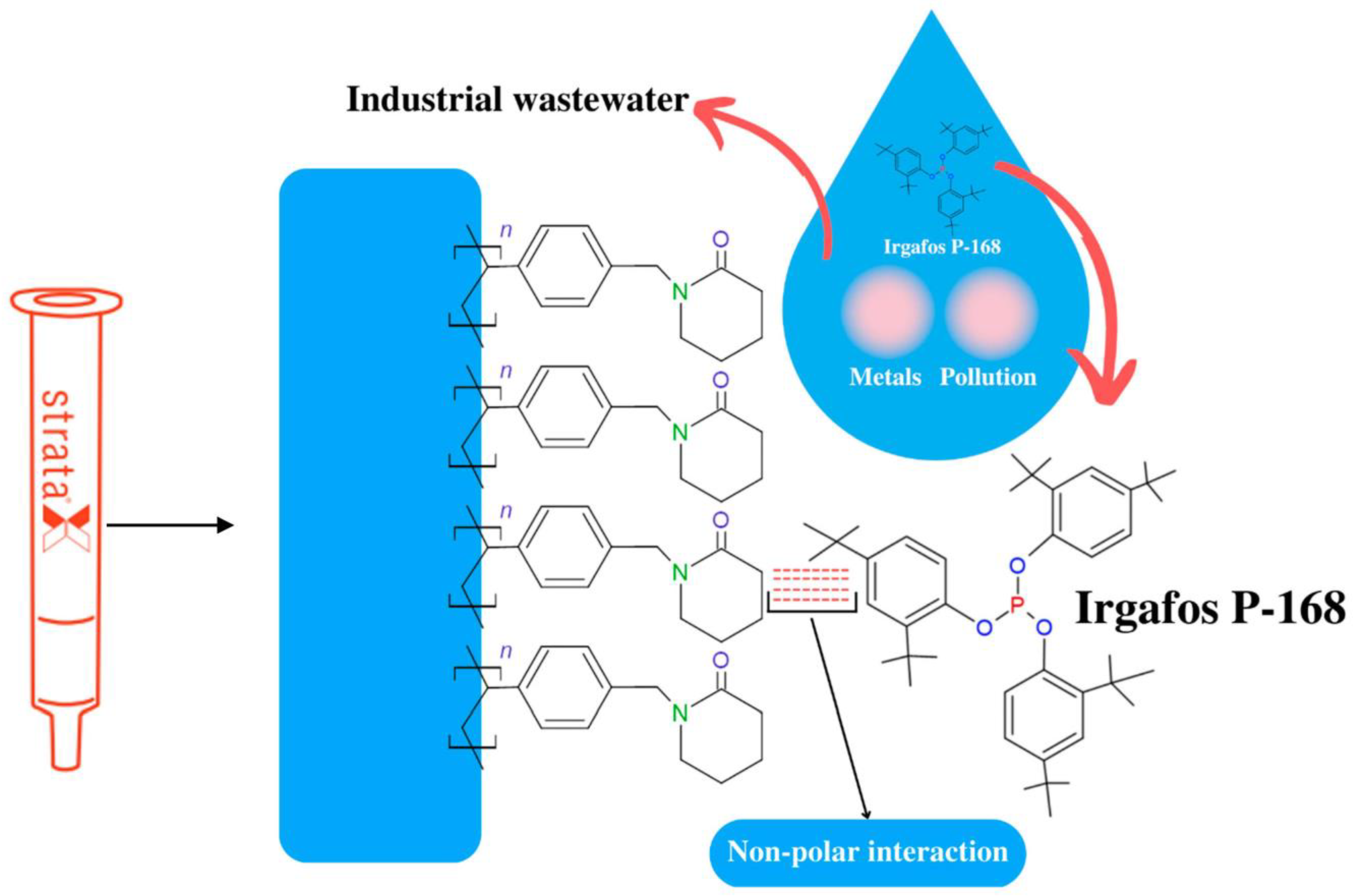

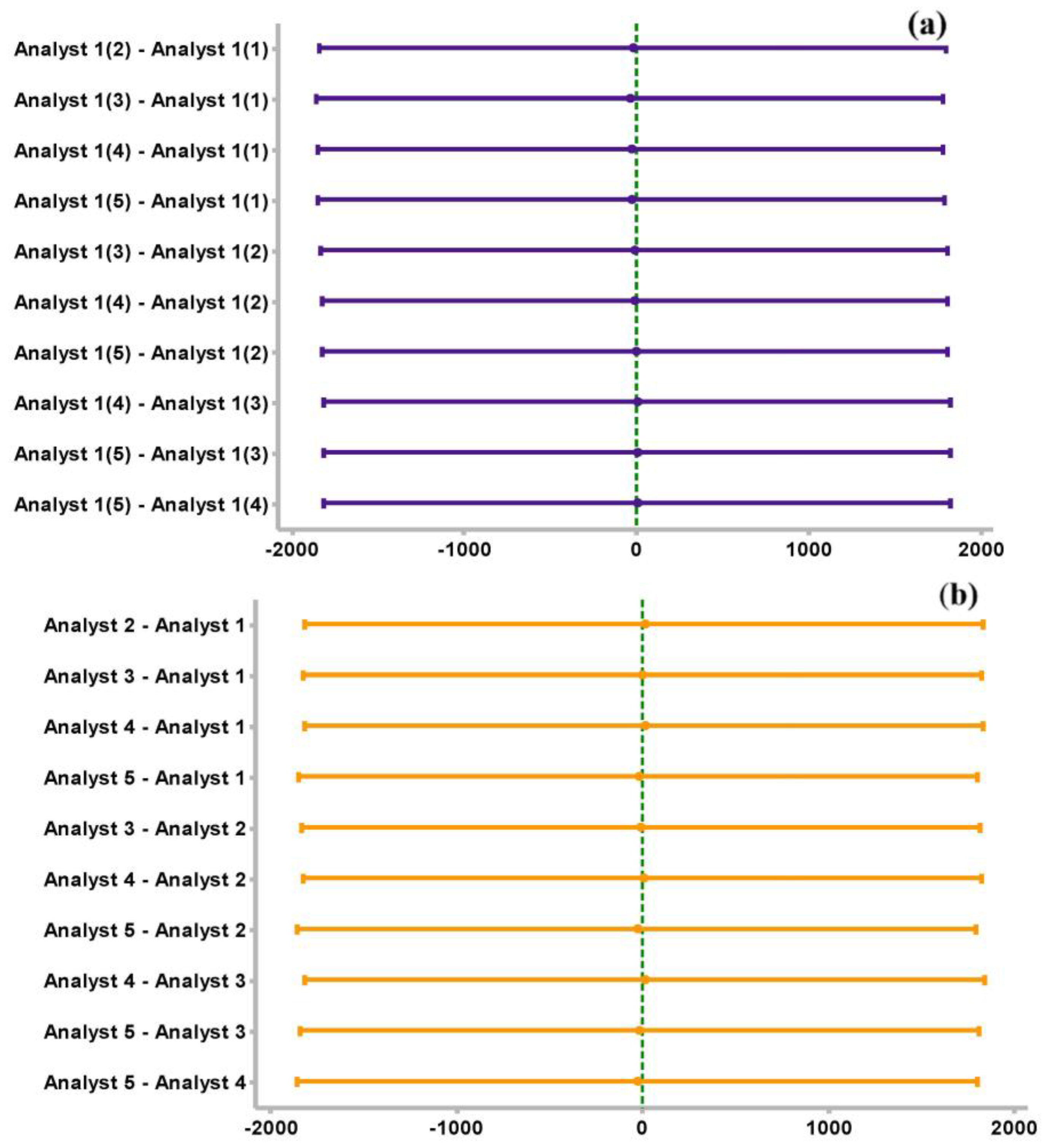
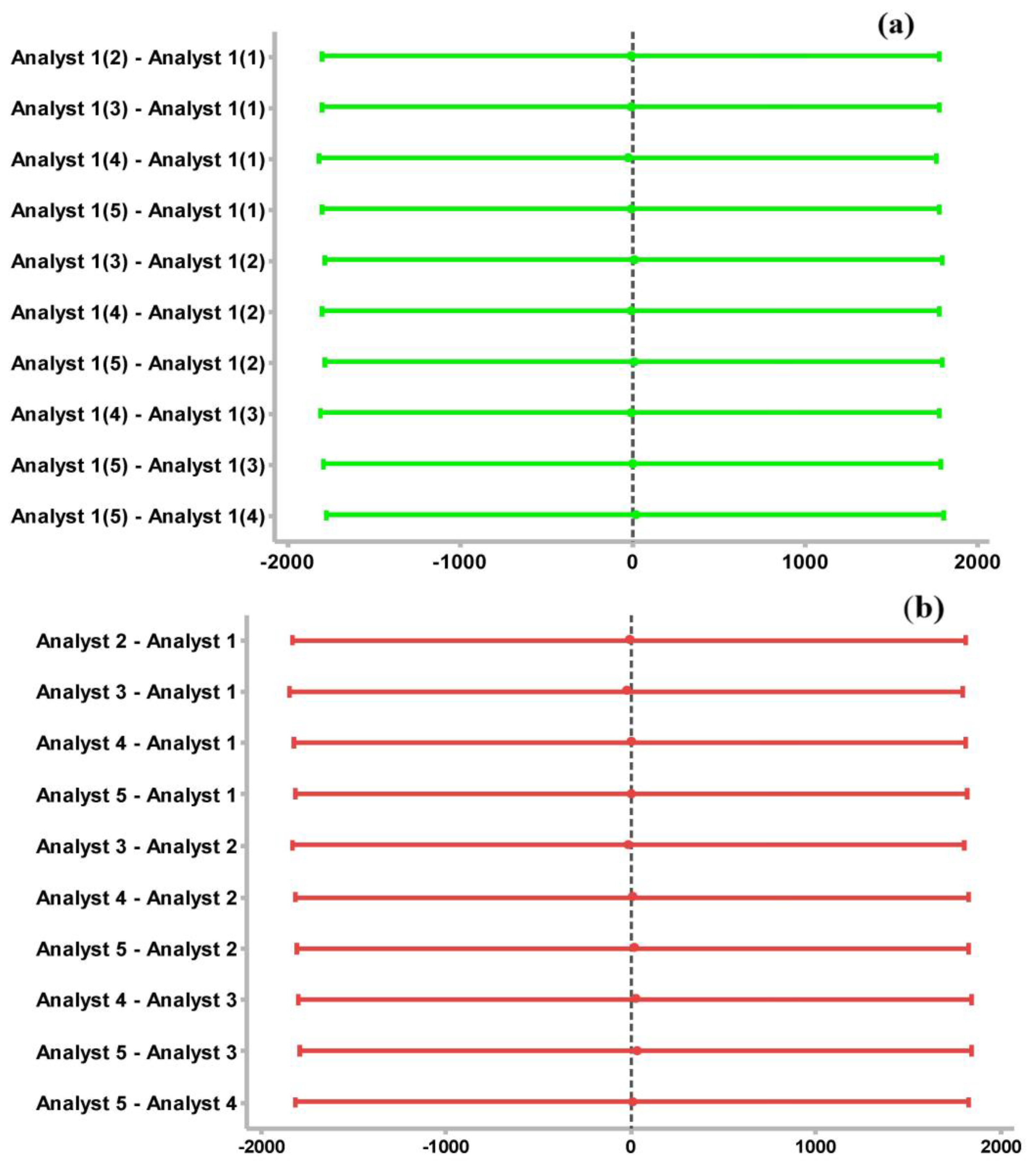

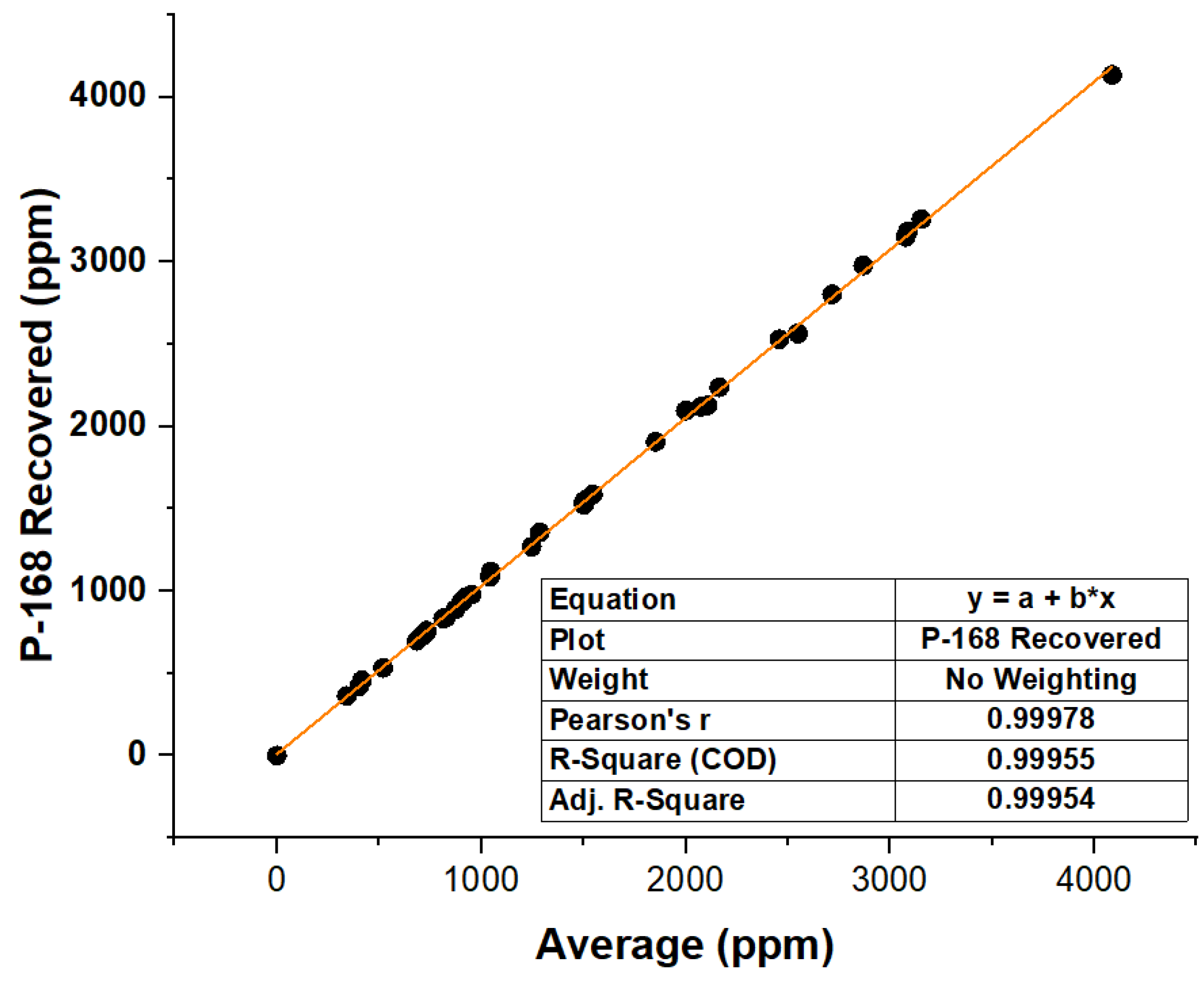
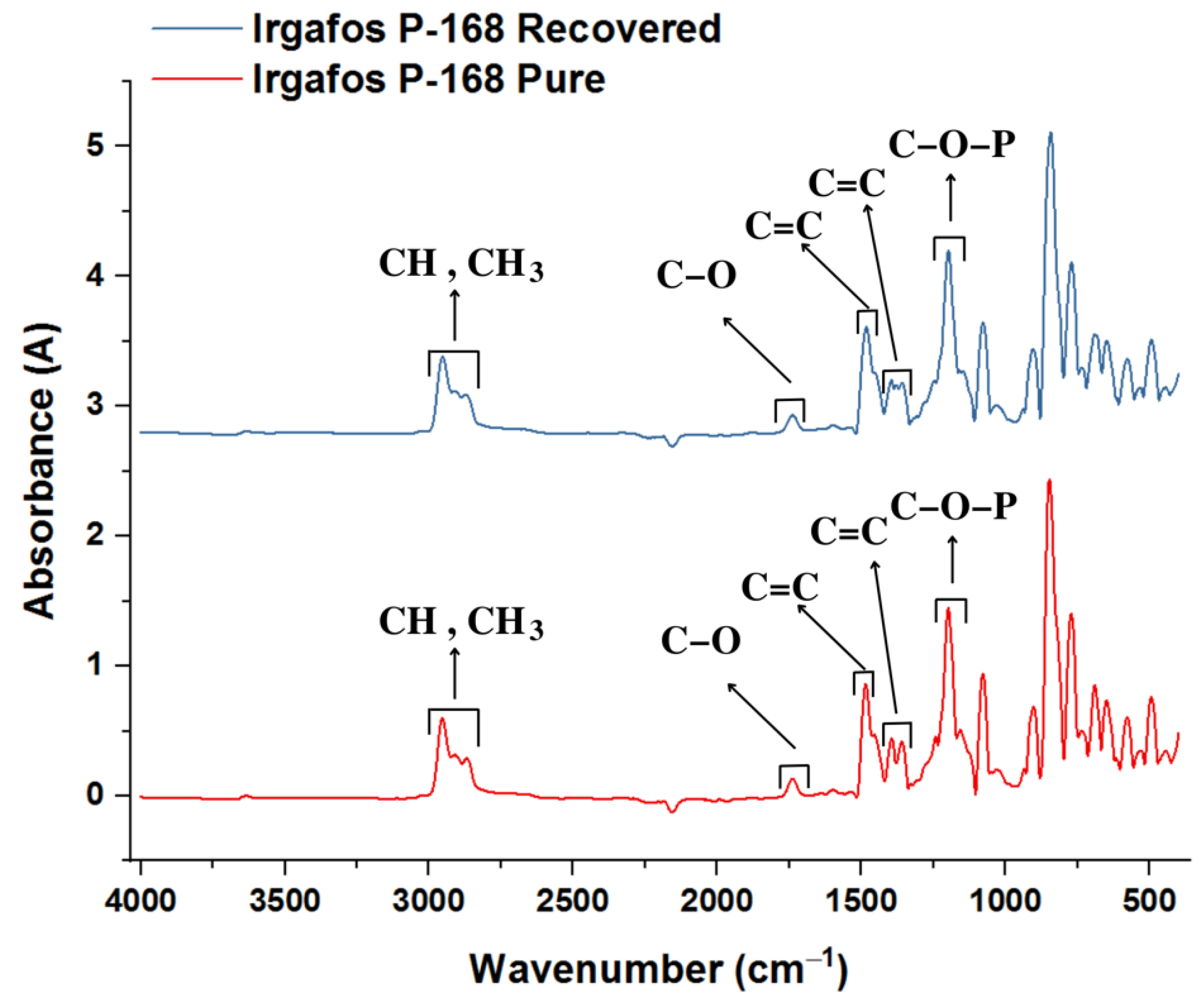
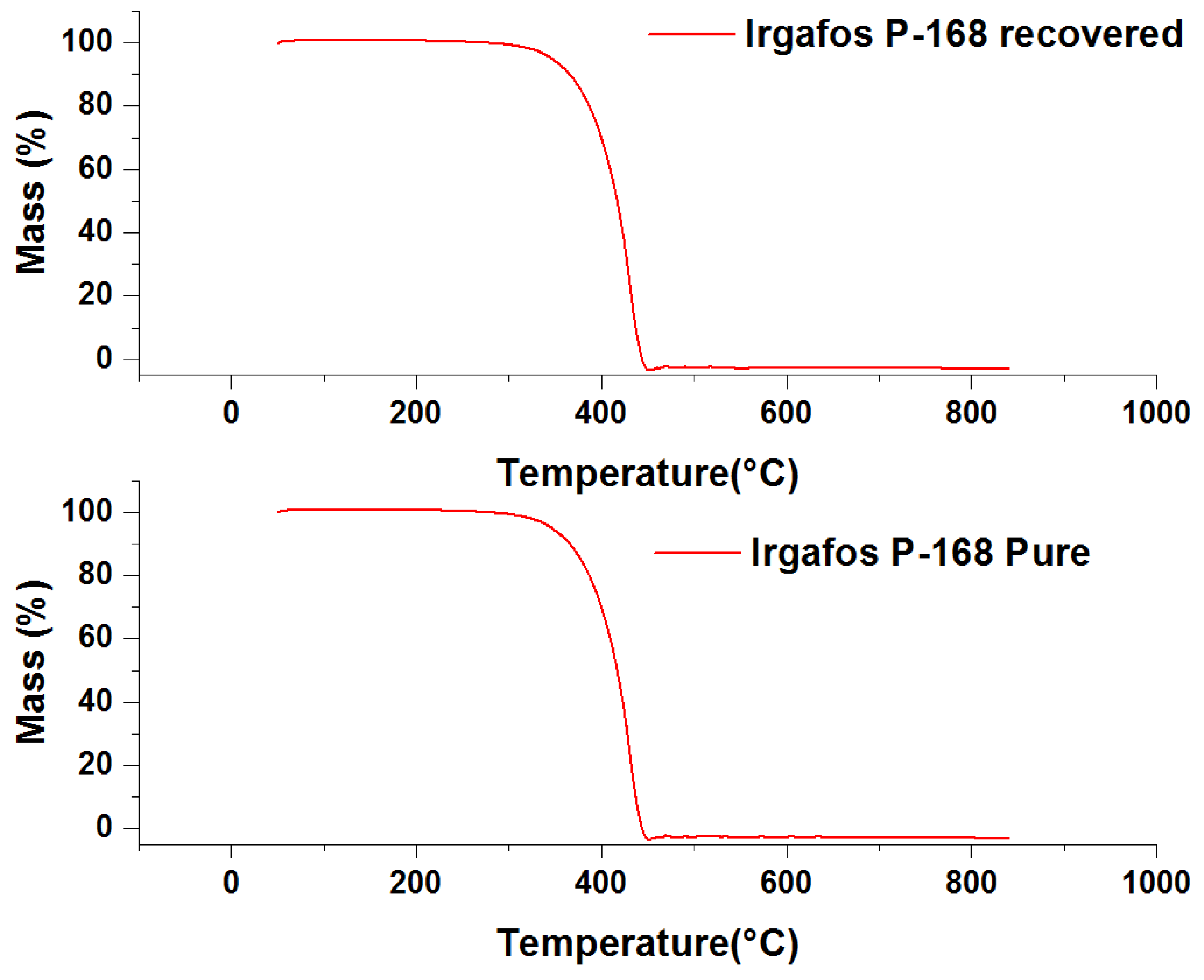
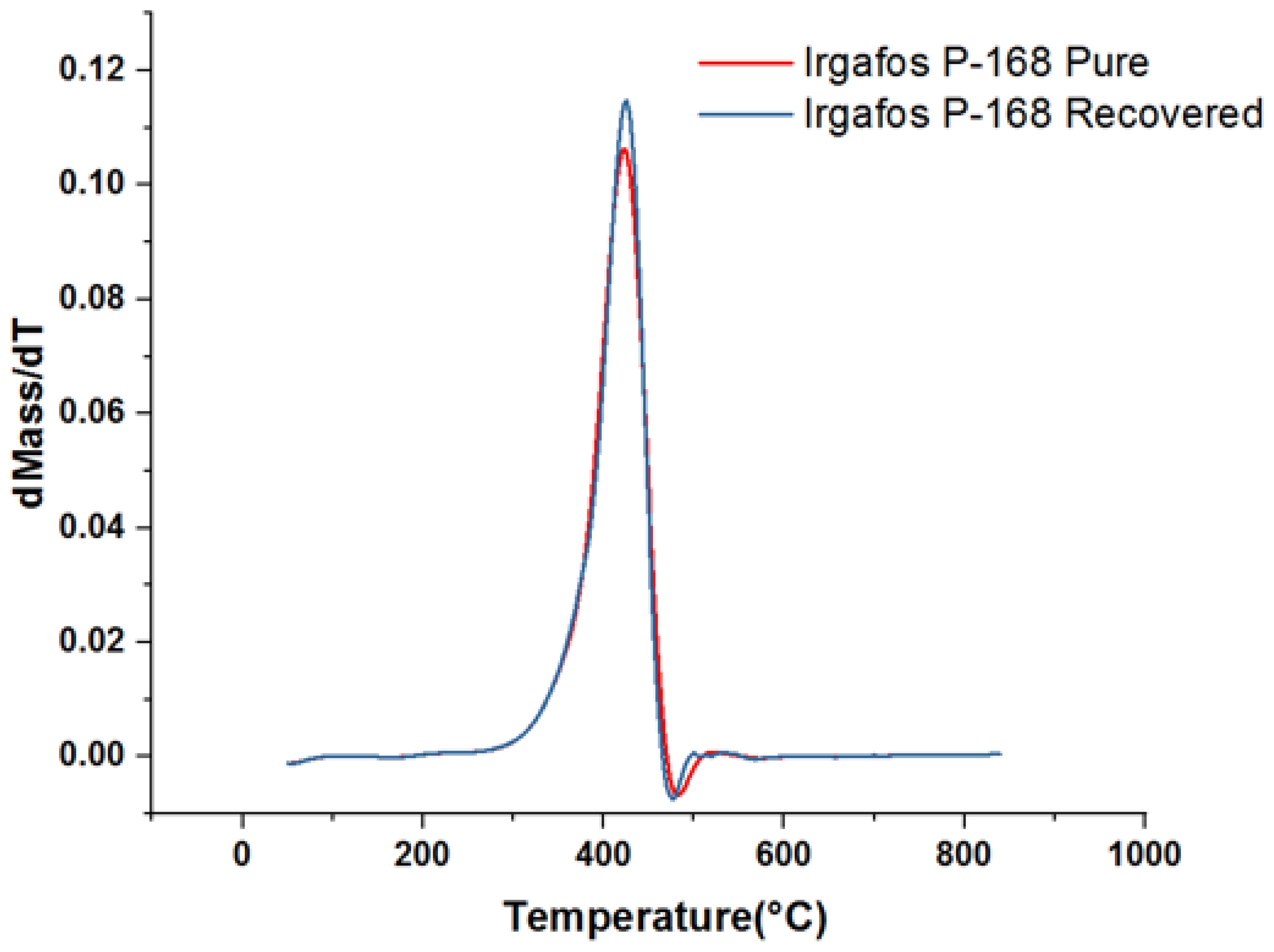

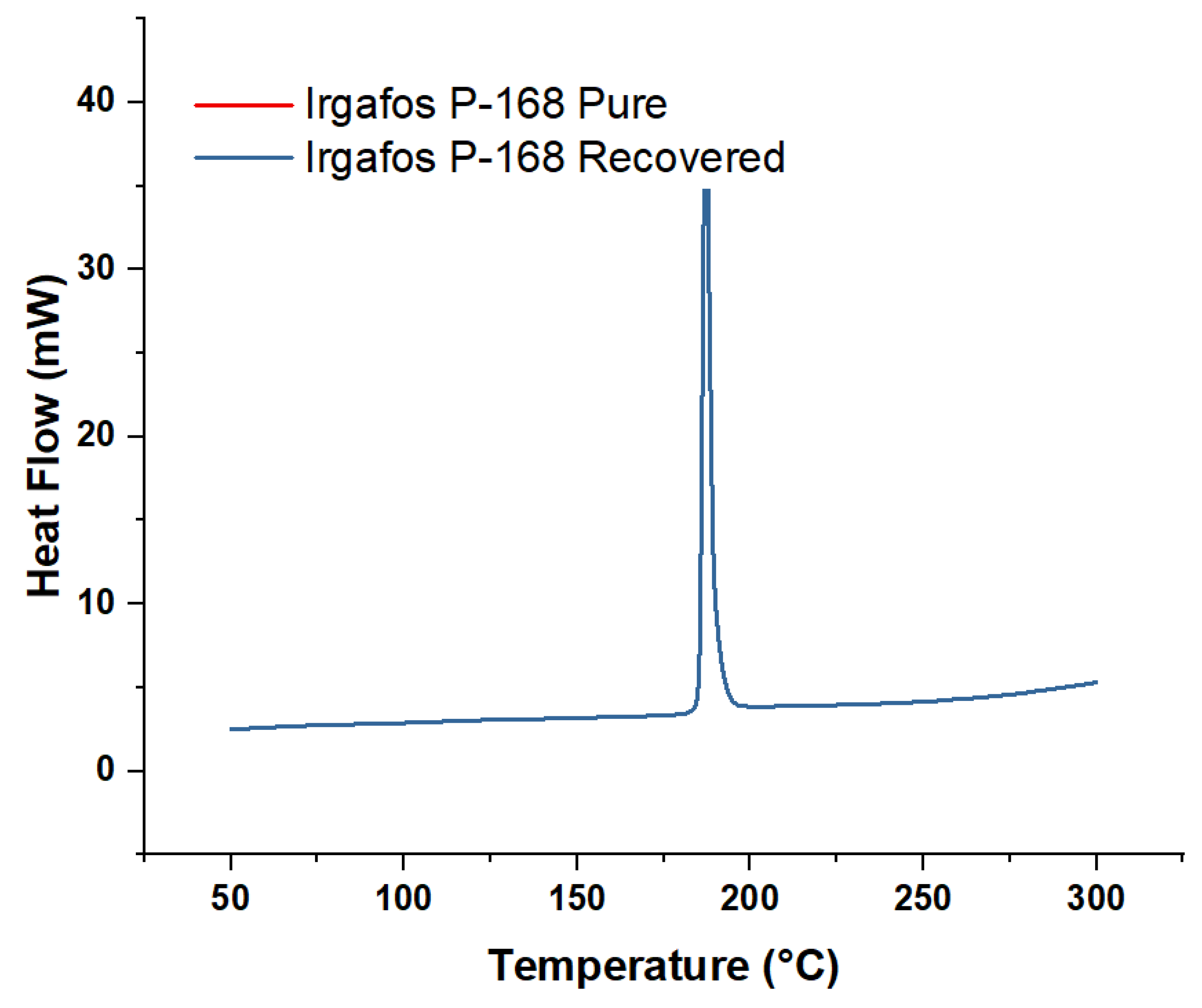

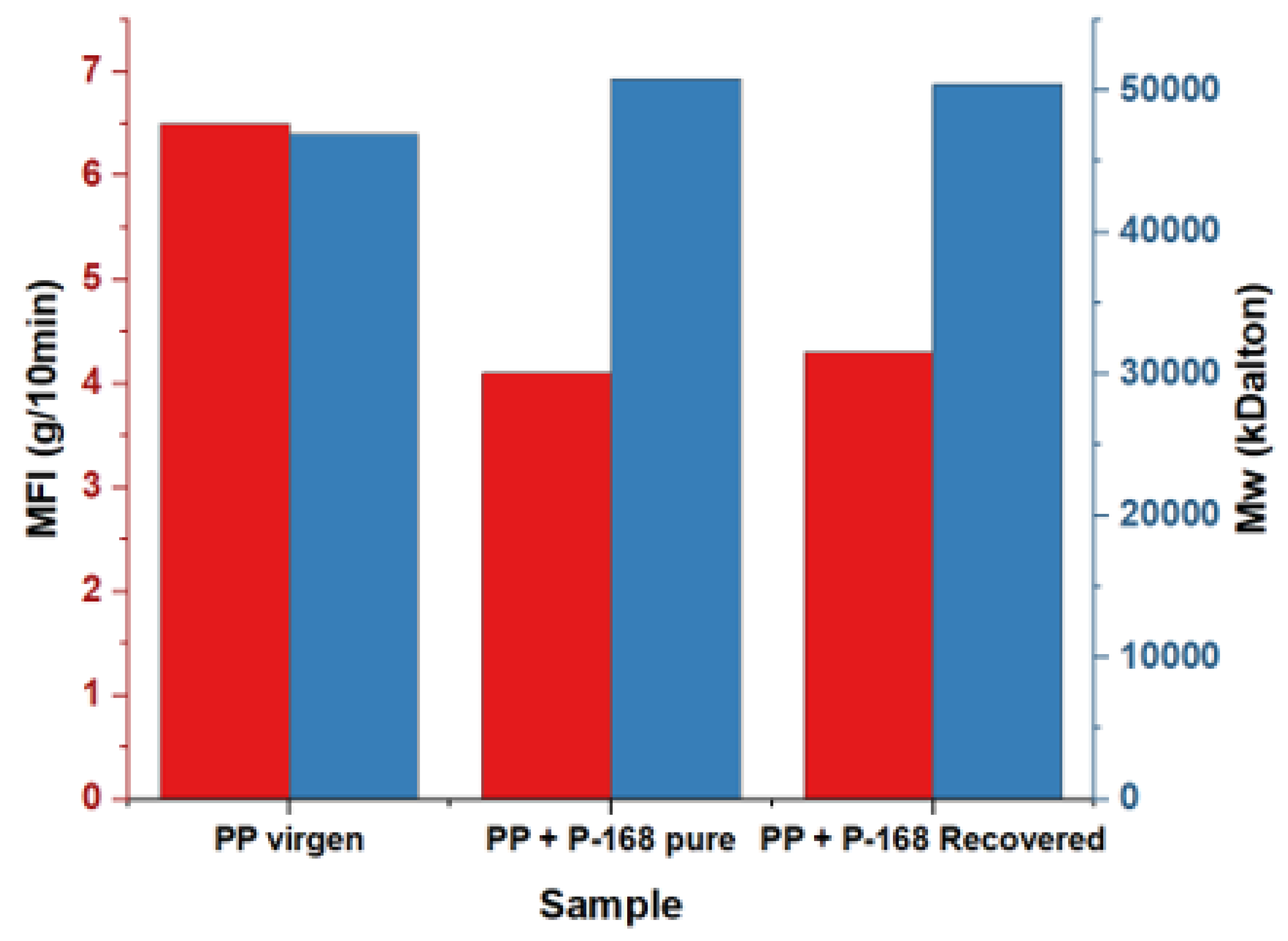
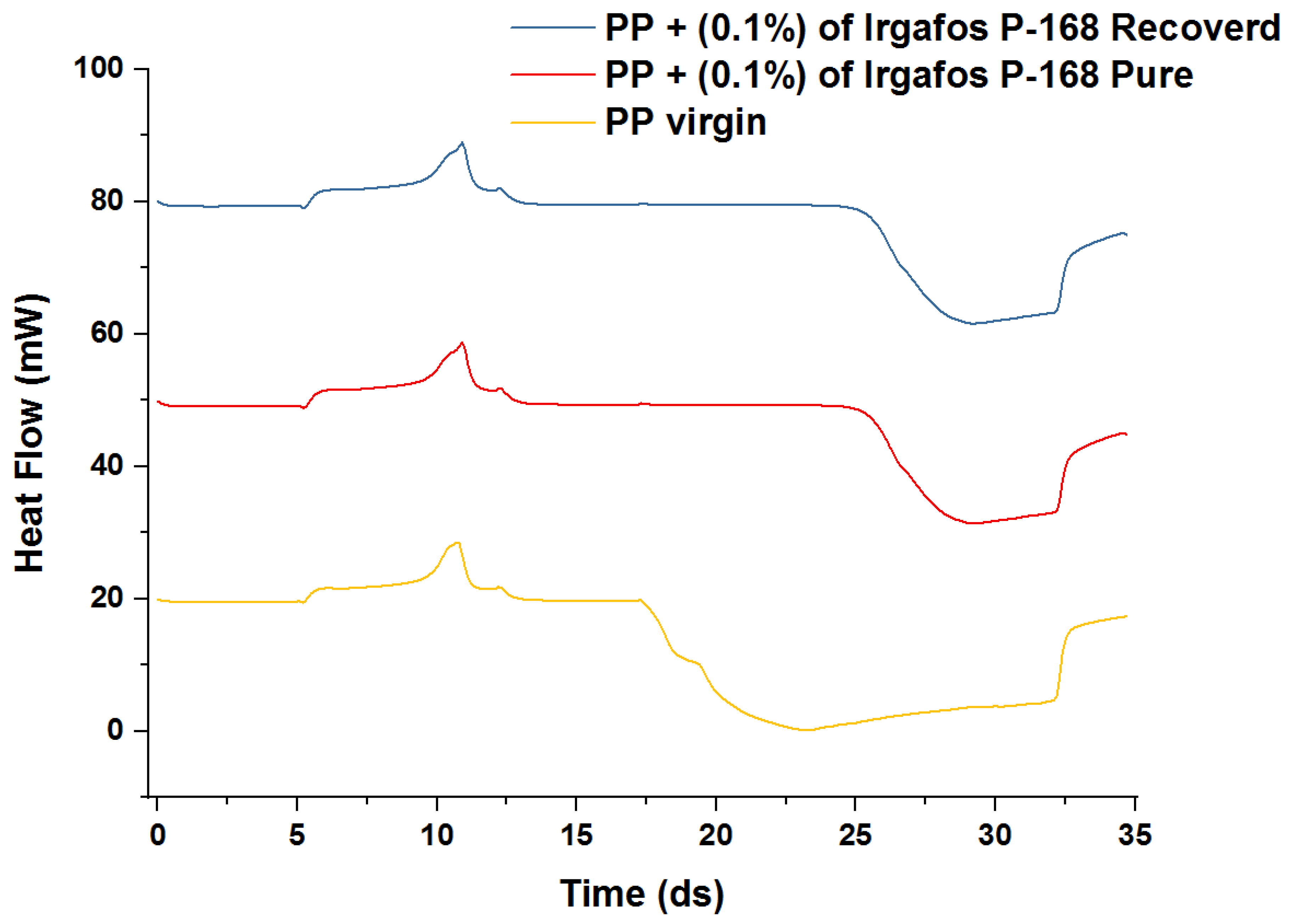
| Values for Irgafos P-168 Quantitation Model by HPLC-MS | |||||||
|---|---|---|---|---|---|---|---|
| Sequence Intraday (Same Day) | |||||||
| Standard | 1 | 2 | 3 | 4 | 5 | 6 | 7 |
| Theoretical | 0 | 500 | 1000 | 1500 | 2000 | 3000 | 5000 |
| Analyst 1 | 0 | 485 | 990 | 1521 | 1991 | 2945 | 4945 |
| Analyst 1 | 0 | 477 | 1010 | 1488 | 1868 | 2929 | 4932 |
| Analyst 1 | 0 | 488 | 977 | 1493 | 1900 | 2845 | 4900 |
| Analyst 1 | 0 | 490 | 965 | 1495 | 1944 | 2737 | 4993 |
| Analyst 1 | 0 | 475 | 981 | 1466 | 1968 | 2910 | 4831 |
| Average | 0 | 483.0 | 984.6 | 1492.6 | 1934.2 | 2873.2 | 4920.2 |
| Deviation | 0 | 6.7 | 16.8 | 19.6 | 50.0 | 85.1 | 60.0 |
| RSD | 0 | 1.4 | 1.7 | 1.3 | 2.6 | 3.0 | 1.2 |
| Error | 0 | 3.4 | 1.5 | 0.5 | 3.3 | 4.2 | 1.6 |
| Sequence Interday (different day) | |||||||
| Standard | 1 | 2 | 3 | 4 | 5 | 6 | 7 |
| Theoretical | 0 | 500 | 1000 | 1500 | 2000 | 3000 | 5000 |
| Analyst 1 | 0 | 443 | 934 | 1435 | 1976 | 2990 | 4956 |
| Analyst 2 | 0 | 456 | 967 | 1521 | 1982 | 2985 | 4880 |
| Analyst 3 | 0 | 482 | 973 | 1491 | 1895 | 2856 | 5014 |
| Analyst 4 | 0 | 495 | 1011 | 1399 | 1989 | 3011 | 4876 |
| Analyst 5 | 0 | 475 | 986 | 1458 | 2013 | 2867 | 4779 |
| Average | 0 | 470.2 | 974.2 | 1460.8 | 1971 | 2941.8 | 4901 |
| Deviation | 0 | 20.7 | 28.1 | 47.5 | 44.7 | 74.1 | 89.1 |
| RSD | 0 | 4.4 | 2.9 | 3.3 | 2.3 | 2.5 | 1.8 |
| Error | 0 | 6 | 2.6 | 2.6 | 1.5 | 1.9 | 2 |
| Values for Irgafos P-168 Extraction Method by SPE | |||||||
|---|---|---|---|---|---|---|---|
| Sequence Intraday (Same Day) | |||||||
| STDA | 1 | 2 | 3 | 4 | 5 | 6 | 7 |
| Theoretical | 0 | 500 | 1000 | 1500 | 2000 | 3000 | 5000 |
| Analyst 1 | 0 | 465 | 933 | 1396 | 1943 | 2950 | 4911 |
| Analyst 1 | 0 | 476 | 969 | 1477 | 1922 | 2854 | 4795 |
| Analyst 1 | 0 | 471 | 972 | 1482 | 1896 | 2889 | 4811 |
| Analyst 1 | 0 | 485 | 985 | 1396 | 1958 | 2756 | 4824 |
| Analyst 1 | 0 | 483 | 932 | 1484 | 1876 | 2949 | 4779 |
| Average | 0 | 476 | 958.2 | 1447 | 1919 | 2879.6 | 4824 |
| Deviation | 0 | 8.3 | 24.2 | 46.6 | 33.5 | 80.3 | 51.5 |
| RSD | 0 | 1.7 | 2.5 | 3.2 | 1.7 | 2.8 | 1.1 |
| Error | 0 | 4.8 | 4.2 | 3.5 | 4.1 | 4 | 3.5 |
| % Recovery | 0 | 95 | 96 | 96 | 96 | 96 | 96 |
| Sequence Intraday (different day) | |||||||
| STDA | 1 | 2 | 3 | 4 | 5 | 6 | 7 |
| Theoretical | 0 | 500 | 1000 | 1500 | 2000 | 3000 | 5000 |
| Analyst 1 | 0 | 481 | 927 | 1533 | 1911 | 2944 | 4890 |
| Analyst 2 | 0 | 477 | 933 | 1478 | 1934 | 2920 | 4869 |
| Analyst 3 | 0 | 469 | 957 | 1461 | 1873 | 2894 | 4835 |
| Analyst 4 | 0 | 481 | 981 | 1432 | 1894 | 2904 | 4943 |
| Analyst 5 | 0 | 493 | 935 | 1491 | 1933 | 2911 | 4905 |
| Average | 0 | 480.2 | 946.6 | 1479 | 1909 | 2914.6 | 4888.4 |
| Deviation | 0 | 8.7 | 22.3 | 37.4 | 26.1 | 19 | 40.3 |
| RSD | 0 | 1.8 | 2.4 | 2.5 | 1.4 | 0.7 | 0.8 |
| Error | 0 | 4 | 5.3 | 1.4 | 4.6 | 2.8 | 2.2 |
| % Recovery | 0 | 96 | 95 | 99 | 95 | 97 | 98 |
| Values for the Extraction Method on Samples of Irgafos P-168 by SPE | |||||||||||
|---|---|---|---|---|---|---|---|---|---|---|---|
| Day | Sample | Analyst 1 | Analyst 2 | Analyst 3 | Analyst 4 | Analyst 5 | Average | Deviation | RSD | Recovery | % Recovery |
| 1 | 1 | 1500 | 1512 | 1524 | 1538 | 1542 | 1523.2 | 17.6 | 1.2 | 1502 | 98.61 |
| 2 | 2 | 2100 | 2104 | 2075 | 2096 | 2104 | 2095.8 | 12.1 | 0.6 | 2000 | 95.43 |
| 3 | 3 | 1978 | 1875 | 1865 | 1910 | 1902 | 1906 | 44.3 | 2.3 | 1853 | 97.22 |
| 4 | 4 | 975 | 963 | 942 | 912 | 925 | 943.4 | 26 | 2.8 | 901 | 95.51 |
| 5 | 5 | 745 | 702 | 649 | 688 | 700 | 696.8 | 34.4 | 4.9 | 685 | 98.31 |
| 6 | 6 | 462 | 463 | 475 | 435 | 450 | 457 | 15.1 | 3.3 | 416 | 91.03 |
| 7 | 7 | 412 | 405 | 418 | 435 | 433 | 420.6 | 13.1 | 3.1 | 402 | 95.58 |
| 8 | 8 | 514 | 524 | 546 | 575 | 502 | 532.2 | 28.9 | 5.4 | 520 | 97.71 |
| 9 | 9 | 912 | 975 | 902 | 934 | 942 | 933 | 28.5 | 3.1 | 912 | 97.75 |
| 10 | 10 | 777 | 800 | 715 | 764 | 738 | 758.8 | 33.2 | 4.4 | 733 | 96.6 |
| 11 | 11 | 1000 | 975 | 956 | 1012 | 943 | 977.2 | 29 | 3 | 925 | 94.66 |
| 12 | 12 | 1426 | 1354 | 1378 | 1300 | 1322 | 1356 | 49.2 | 3.6 | 1286 | 94.84 |
| 13 | 13 | 1542 | 1523 | 1567 | 1500 | 1586 | 1543.6 | 34.2 | 2.2 | 1508 | 97.69 |
| 14 | 14 | 947 | 977 | 968 | 942 | 975 | 961.8 | 16.2 | 1.7 | 952 | 98.98 |
| 15 | 15 | 871 | 822 | 809 | 839 | 826 | 833.4 | 23.6 | 2.8 | 826 | 99.11 |
| 16 | 16 | 766 | 743 | 709 | 785 | 768 | 754.2 | 29.4 | 3.9 | 733 | 97.19 |
| 17 | 17 | 700 | 705 | 766 | 745 | 735 | 730.2 | 27.7 | 3.8 | 716 | 98.06 |
| 18 | 18 | 974 | 955 | 961 | 908 | 911 | 941.8 | 30.3 | 3.2 | 904 | 95.99 |
| 19 | 19 | 850 | 824 | 809 | 834 | 870 | 837.4 | 23.6 | 2.8 | 813 | 97.09 |
| 20 | 20 | 352 | 342 | 365 | 385 | 366 | 362 | 16.2 | 4.5 | 342 | 94.48 |
| 21 | 21 | 711 | 702 | 742 | 733 | 746 | 726.8 | 19.4 | 2.7 | 709 | 97.55 |
| 22 | 22 | 911 | 915 | 908 | 977 | 934 | 929 | 28.7 | 3.1 | 913 | 98.28 |
| 23 | 23 | 1201 | 1245 | 1286 | 1300 | 1311 | 1268.6 | 45.3 | 3.6 | 1246 | 98.22 |
| 24 | 24 | 1542 | 1575 | 1563 | 1646 | 1602 | 1585.6 | 40.1 | 2.5 | 1546 | 97.5 |
| 25 | 25 | 2142 | 2092 | 2105 | 2134 | 2158 | 2126.2 | 27.1 | 1.3 | 2106 | 99.05 |
| 26 | 26 | 2535 | 2564 | 2571 | 2509 | 2641 | 2564 | 49.6 | 1.9 | 2548 | 99.38 |
| 27 | 27 | 3102 | 3152 | 3136 | 3184 | 3172 | 3149.2 | 32.2 | 1 | 3086 | 97.99 |
| 28 | 28 | 4150 | 4135 | 4106 | 4172 | 4108 | 4134.2 | 28.1 | 0.7 | 4087 | 98.86 |
| 29 | 29 | 3012 | 2975 | 2942 | 2955 | 3001 | 2977 | 29.6 | 1 | 2869 | 96.37 |
| 30 | 30 | 2807 | 2645 | 2711 | 2908 | 2938 | 2801.8 | 125.2 | 4.5 | 2716 | 96.94 |
| 31 | 31 | 2148 | 2299 | 2108 | 2276 | 2354 | 2237 | 104.4 | 4.7 | 2165 | 96.78 |
| 32 | 32 | 1545 | 1506 | 1562 | 1575 | 1536 | 1544.8 | 26.4 | 1.7 | 1502 | 97.23 |
| 33 | 33 | 2015 | 2106 | 2185 | 2153 | 2137 | 2119.2 | 64.8 | 3.1 | 2076 | 97.96 |
| 34 | 34 | 3102 | 3245 | 3371 | 3262 | 3312 | 3258.4 | 100.3 | 3.1 | 3154 | 96.8 |
| 35 | 35 | 2571 | 2534 | 2516 | 2509 | 2511 | 2528.2 | 25.9 | 1 | 2459 | 97.26 |
| 36 | 36 | 3014 | 3105 | 3275 | 3209 | 3315 | 3183.6 | 123.7 | 3.9 | 3077 | 96.65 |
| 37 | 37 | 1091 | 1142 | 1162 | 1085 | 1108 | 1117.6 | 33.3 | 3 | 1046 | 93.59 |
| 38 | 38 | 872 | 877 | 908 | 913 | 873 | 888.6 | 20.2 | 2.3 | 875 | 98.47 |
| 39 | 39 | 1075 | 1011 | 1134 | 1126 | 1088 | 1086.8 | 49.1 | 4.5 | 1042 | 95.88 |
| 40 | 40 | 1542 | 1500 | 1612 | 1573 | 1546 | 1554.6 | 41.4 | 2.7 | 1514 | 97.39 |
| Qualification Ions of the Irgafos Pure (m/z) | Qualification Ions of the Irgafos Recovered (m/z) | Approximate Relative Abundance |
|---|---|---|
| 57 | 57 | 49.0% |
| 91 | 91 | 4.8% |
| 147 | 147 | 29.8% |
| 191 | 191 | 11.8% |
| 237 | 237 | 4.7% |
| 308 | 308 | 7.8% |
| 329 | 329 | 8.0% |
| 385 | 385 | 12.1% |
| 441 | 441 | 100% |
| 646 | 646 | 12.28% |
Disclaimer/Publisher’s Note: The statements, opinions and data contained in all publications are solely those of the individual author(s) and contributor(s) and not of MDPI and/or the editor(s). MDPI and/or the editor(s) disclaim responsibility for any injury to people or property resulting from any ideas, methods, instructions or products referred to in the content. |
© 2023 by the authors. Licensee MDPI, Basel, Switzerland. This article is an open access article distributed under the terms and conditions of the Creative Commons Attribution (CC BY) license (https://creativecommons.org/licenses/by/4.0/).
Share and Cite
Hernández-Fernández, J.; Cano, H.; Reyes, A.F. Valoration of the Synthetic Antioxidant Tris-(Diterbutyl-Phenol)-Phosphite (Irgafos P-168) from Industrial Wastewater and Application in Polypropylene Matrices to Minimize Its Thermal Degradation. Molecules 2023, 28, 3163. https://doi.org/10.3390/molecules28073163
Hernández-Fernández J, Cano H, Reyes AF. Valoration of the Synthetic Antioxidant Tris-(Diterbutyl-Phenol)-Phosphite (Irgafos P-168) from Industrial Wastewater and Application in Polypropylene Matrices to Minimize Its Thermal Degradation. Molecules. 2023; 28(7):3163. https://doi.org/10.3390/molecules28073163
Chicago/Turabian StyleHernández-Fernández, Joaquín, Heidis Cano, and Ana Fonseca Reyes. 2023. "Valoration of the Synthetic Antioxidant Tris-(Diterbutyl-Phenol)-Phosphite (Irgafos P-168) from Industrial Wastewater and Application in Polypropylene Matrices to Minimize Its Thermal Degradation" Molecules 28, no. 7: 3163. https://doi.org/10.3390/molecules28073163





